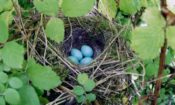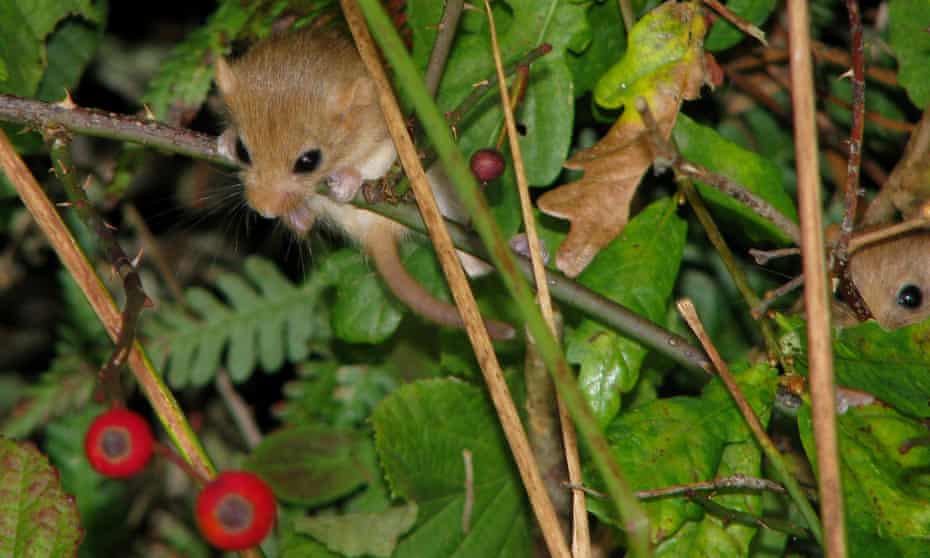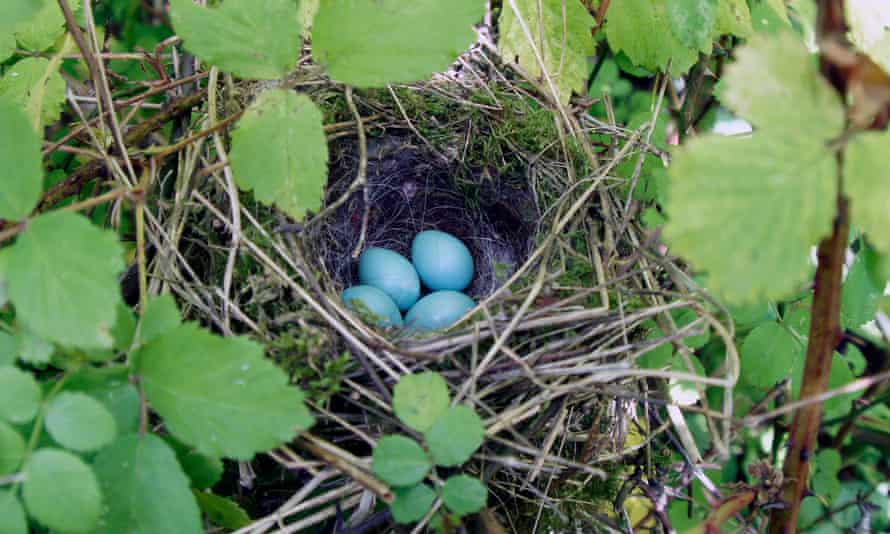Waldorf News
‘Reservoirs of life’: how hedgerows can help the UK reach net zero in 2050

They store carbon and are havens for wildlife – it’s no wonder experts are calling for Britain’s hedge network to be extended
By Phoebe Weston
One New Year’s Day, ecologist Rob Wolton came up with an unusual resolution – to spend the next 12 months studying a hedge 40 metres from his house in the middle of Devon. He wanted to make a list of every plant, animal and fungus that used it. Why? Because a wildlife-enthusiast friend challenged him to do it during a long car journey.
“I thought it would take a year, but at the end of the first one I was still finding masses of new species so decided to carry on for another,” he says.

Young dormice photographed by ecologist Rob Wolton during a two-year study of his hedge in Devon. Photograph: Robert Wolton
That was 10 years ago. After two years of observations he had found 2,000 species – far more than he imagined. Not everyone’s idea of fun (even in lockdown), it’s perhaps not surprising that such a detailed study of a single hedge has not been done before or since. Wolton says he enjoyed it hugely and his findings contribute to the growing body of evidence that humble hedgerows should not be overlooked.
“They are reservoirs of life,” he says. “We’re so big, that when you walk past a hedge, you see very little. If you were an ant or something, you would see a vast array of life … It’s only when you look closely that you find all this stuff. And it’s an extraordinary amount of stuff.”
The UK is one of the most hedge-dense countries in the world. These ecological hotspots are the seams of the country’s “patchwork quilt”. There are 500,000km of hedgerows (compared with 400,000km of roads) and there are signs this quintessential feature could grow. “Recently there’s been quite a lot of policy interest in hedgerows here in the UK,” Jo Staley, a hedgerow ecologist at the UK Centre for Ecology and Hydrology, told the Oxford Real Farming Conference in January. “There are some strong policy drivers coming through for potentially expanding hedgerows.”
There were two rules to Wolton’s challenge – wildlife had to be seen within two metres of the hedge and big enough to see with the naked eye. Each week Wolton spent a few days studying the hedge, with the help of a handmade net, a malaise trap and a light trap. Unsurprisingly, the vast majority of species found (83%) were insects. He found 17% of all true flies, butterflies and moths recorded in the British Isles in his 85-metre-long study site.
Thrush, dunnock and bullfinch were found nesting inside, as well as a dormouse bringing up its youngsters in the brambles. Common toads, lizards, grass snakes, long-eared bats, pipistrelles and hedgehogs were also among its inhabitants.
The hedge is 20 metres from a pond, 130 metres from a native broadleaf wood, and surrounded by nature-friendly farmland, which means it is probably particularly good for wildlife – Wolton estimates that the hedge supports nearer 3,000 species in total. “There is increasing recognition that within intensively farmed landscapes, much of the wildlife finds refuge in the hedges. But they’re much more than just wildlife corridors – they are really important as habitats in their own right,” he says.
The European commission’s Joint Research Centre recently argued that planting new hedgerows was one of the best – if not only – ways to combat ecosystem fragmentation in intensively farmed landscapes.
As the climate crisis escalates, hedgerows are expected to become even more important as highways for wildlife as they move in response to environmental change. Their deep roots also help sequester carbon, and the UK’s Committee on Climate Change 2019 report suggested the hedgerow network be extended by 40% as part of the UK’s 2050 net zero target.
Hedges also reduce the likelihood of flooding downstream, suck nutrients and pollutants out of water, and prevent soil erosion. Birds, butterflies and bees have all been shown to navigate landscapes using hedgerows. Earlier this month, the National Botanic Garden of Wales pointed out that the UK needs more old-fashioned, flower-filled hedgerows and grasslands to help boost declining populations of honeybees and other pollinators. More hedges would make them less reliant on crops such as oilseed rape (which are can be treated with honeybee-harming neonicotinoid insecticides) and the invasive Himalayan balsam flower.
On account of their high biodiversity value, Natural England, the country’s environment watchdog, has recommended England’s hedgerow network should increase by 60%. The National Farmers’ Union has also told members that hedgerows should be allowed to grow bigger and taller to support more wildlife.

A dunnock’s nest containing eggs in Rob Wolton’s hedge. Thrush and bullfinch also made their homes in the hedgerow. Photograph: Robert Wolton
Alongside quaint villages and rolling hills, hedges are also an important feature of UK heritage. “There is a cultural, and potentially aesthetic, benefit to hedges too – I think lots of us who live in England think of the hedge landscape as being quite archetypal,” says Staley.
Referring to maps is the best way to date hedges, but species diversity is also a good indicator of age. Wolton’s hedge appears on an 1845 parish map but it could be older. A quarter of hedgerows in Devon – known for being healthy, wide and mixed-species – are believed to be more than 800 years old, meaning they pre-date many historic buildings such as parish churches. Some Cornish hedgerows are believed to date back 4,000 years, making them among the country’s oldest man-made features.
Their original purpose in marking boundaries and keeping in livestock became less important with the arrival of modern fencing materials and after the second world war many hedges were removed as part of a drive to create more productive land.
However, their role in protecting wildlife was a key justification for their continuation, and England and Wales brought in the Hedgerows Regulations 1997, so were among the first countries to provide hedges with protection. It became illegal to remove hedges in England and Wales without permission from the council.
Despite these strong protections, only about one in three hedgerows in England are in good condition, according to the most recent research, which was done in 2007, and sorting this out is as important as extending the existing network. “In terms of improving the quality of hedges, this is a problem everywhere. Even in Devon, a lot of our hedges are not nearly as good as they could be because they’re not managed well,” says Wolton.
The main issues are hedges being cut too severely and too frequently, which leads to loss of wildlife and gaps. Gaps mean habitats are cut off from one another – a dormouse, for example, will turn around if there is a gap of five metres. New hedges are being planted with single species, instead of many, which diminishes the wildlife they can support.
It’s hard to say if policy interest in hedgerows will translate into action on a national scale, and much depends on what landscape features the government subsidises as part of its post-EU Environmental Land Management scheme (Elms).
Wolton is quietly confident. “Elms is there to support the delivery of public goods by farmers, including biodiversity. We would all be hugely surprised if hedges weren’t a major element of that.
“They’re great for carbon, they’re great for wildlife and they’re great for a whole lot of other public benefits as well.”
 Storytelling Skills for Teachers
Storytelling Skills for Teachers Flexible preparation for your new grade
Flexible preparation for your new grade Immersive Academics and Arts
Immersive Academics and Arts Transforming Voices Worldwide
Transforming Voices Worldwide Discovering the Wisdom of Childhood
Discovering the Wisdom of Childhood Association for a Healing Education
Association for a Healing Education Grade Level Training in Southern California
Grade Level Training in Southern California Apply Today: New Cohort Starts Nov. 2025
Apply Today: New Cohort Starts Nov. 2025 The Art of Administration and Leadership
The Art of Administration and Leadership Jamie York Books, Resources, Workshops
Jamie York Books, Resources, Workshops Quality Education in the Heartland
Quality Education in the Heartland Train to Teach in Seattle
Train to Teach in Seattle Roadmap to Literacy Books & Courses
Roadmap to Literacy Books & Courses Space speaks. Its language is movement.
Space speaks. Its language is movement. Waldorf EC Training & Intensives in Canada
Waldorf EC Training & Intensives in Canada ~ Ensoul Your World With Color ~
~ Ensoul Your World With Color ~ Middle School Science With Roberto Trostli
Middle School Science With Roberto Trostli Bringing Love to Learning for a Lifetime
Bringing Love to Learning for a Lifetime Summer Programs - Culminating Class Trips
Summer Programs - Culminating Class Trips Full-Time Teacher Education
Full-Time Teacher Education Caring for All Stages of Life
Caring for All Stages of Life Bay Area Teacher Training
Bay Area Teacher Training The Journey is Everything
The Journey is Everything Everything a Teacher Needs
Everything a Teacher Needs Waldorf-inspired Homeschool Curriculum
Waldorf-inspired Homeschool Curriculum Art of Teaching Summer Courses 2025
Art of Teaching Summer Courses 2025 Dancing for All Ages
Dancing for All Ages RSS Feeds
RSS Feeds